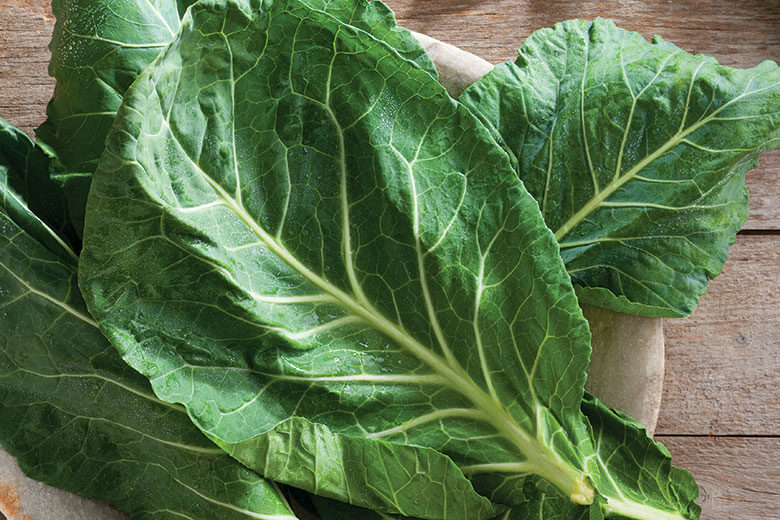
A headless, primitive ancestor of wild sea cabbage, collard greens lack the social media fame of their close relative kale, but collards are beloved by cooks who appreciate affordable, delicious and nutritious greens. The official state vegetable of South Carolina, collards come from the non-heading acephala variety of the mustard family Brassicacae. Originating in the Eastern Mediterranean region, the vegetable’s cruciferous culinary roots date back 2,000 years to Greek and Roman gardens. In the 17th century, British settlers brought collard seeds to the colonies where laborers, primarily enslaved Africans, embraced and positioned them to become a valued and traditional vegetable of the South.
Grown in a rosette of leaves radiating from the center, varieties range from bright green to gray-blue-green and sprout paddle-shaped leaves with smooth or ruffled edges.
In the Kitchen: Because collard greens and kale can be prepared using the same methods, kale’s popularity has created many recipes for using collards in smoothies, salads, dips, soups, casseroles and as chips. To embrace classic Southern collards, braise or stew them with aromatic vegetables and cured fatty meats such as ham hocks or bacon. Strain the savory liquids for potlikker, a greenish-gray juice containing nutrients from collards, then drink it or use as soup stock or for flavoring rice and vegetables.
Sautéing and blanching maintain collards’ green color and slightly chewy texture. Remove tough stems, chop and sauté separate from the leaves or toss in soups or stews. To blanch, cook whole de-stemmed leaves in simmering water for up to three minutes, then cool in an ice bath. Stuff the leaves and cook like cabbage rolls or slice thin and add to the final stages of cooked dishes.
For raw applications including salads and slaws, stack de-stemmed leaves and slice in thin strips perpendicular to the veins to minimize tough texture. Pickle collard greens or toss leaves into a blender with basil for collard pesto.
Collards’ Mediterranean heritage appears in savory pies from Greece, Southern France and Italy and in caldo verde, a popular Portuguese soup. This vegetable also integrates well with spices and ingredients of South Asia, Africa and India. In South America, collard dishes often include smoked meats.
In the Clinic: One cup of boiled, chopped collard greens contains about 60 calories, 8 grams of fiber and 5 grams of protein. This portion is an excellent source of calcium and vitamins A, C and K, and a good source of iron, riboflavin, vitamin B6 and choline.
While cooking collards, the bitter, strong flavors and odors result from flavor precursor compounds such as glucosinolates. These nitrogen- and sulfur-containing compounds break down during food preparation, chewing and digestion into indoles and isothiocyanates, such as sulforaphane. Emerging research suggest these have anti-cancer properties: Sulforaphane may reduce risk of gastric inflammation and protect against Helicobacter pylori bacteria in the stomach wall, which is linked with the development of ulcers and stomach cancer.
Like other cruciferous vegetables, collards are goitrogenic and contain compounds that may affect iodine levels and thyroid health in individuals with less than optimal iodine intake or with an existing thyroid condition. Foods high in vitamin K can change warfarin effectiveness when consumed in large quantities or if intake levels change suddenly.
In Quantity: The taste and texture of collards, like other greens, vary by climate and harvest time. In late winter and early spring, their thick leaves soften and sharp grassy flavors turn sweeter and less bitter. Because they’re tolerant to both cold and hot climates, menus can include fresh options year round. Collard greens are sold fresh in 8- to 24-ounce bunches and, for foodservice, are packed 25 pounds per box or available 6 to a case in #10 cans. Blanch, drain and freeze large quantities of collards for future use. Rinse collard greens well just before cooking, but if storing for later use, wrap in slightly damp paper towels and a large plastic bag to maintain quality in the refrigerator for five to seven days.
References
Canned Collard Greens. Webstaurant Store website. Accessed November 5, 2018.
Cericola L. The Best Way to Eat Collard Greens is to Sip Them. Southern Living website. Accessed October 15, 2018.
Cruciferous Vegetables and Cancer Prevention. National Cancer Institute website. Reviewed June 7, 2012. Accessed October 25, 2018.
Cruciferous Vegetables. Oregon State University: Linus Pauling Institute, Micronutrient Information Center website. Updated December 2016. Accessed October 25, 2018.
Davis EH. The Humble but Hardy Leaf that Defines our National Character: The Collard Green, Born of Trans-Atlantic Trading, Embodies the Mix of European and African Cultures. Zocalo Public Square website. Accessed October 10, 2018.
FoodKeeper App: Greens. Foodsafety.gov website. Accessed December 11, 2018.
Harris JB. Green, I love you, Greens. Southern Foodways Alliance website. Accessed October 15, 2018.
Herbst ST, Herbst R. The Deluxe Food Lover’s Companion. Hauppauge, NY: Barron’s Educational Series, Inc.; 2009.
Kiple KF, Ornelas KC, eds. The Cambridge World History of Food, Vol 1. Cambridge, United Kingdom: Cambridge University Press; 2000:290-291.
Larson Duyff R. Academy of Nutrition and Dietetics Complete Food and Nutrition Guide. 5th ed. Boston, MA: Houghton Mifflin Harcourt; 2017.
Madison D. Vegetable Literacy. Berkeley, CA: Ten Speed Press; 2013:125-126.
National Nutrient Database for Standard Reference Release, April 2018. United States Department of Agriculture/National Agricultural Library website. Accessed October 15, 2018.
Olson SM, Freeman JH. Selecting Collard Varieties Based on Yield, Plant Habit and Bolting. UF/IFAS North Florida Research and Education Center. http://edis.ifas.ufl.edu/hs353 Reviewed December 2016. Accessed October 10, 2018.
South Carolina General Assembly: 119th Session, 2011-2012. South Carolina Legislature website. Accessed October 10, 2018.
Watch Your Garden Grown: Collards. University of Illinois Extension. Accessed November 5, 2018.
What’s New and Beneficial About Collard Greens. The World’s Healthiest Foods website. Accessed October 25, 2018.





